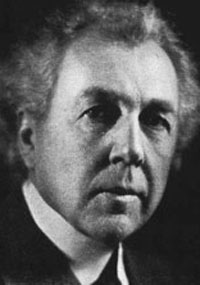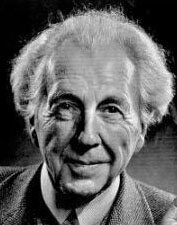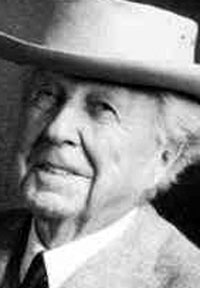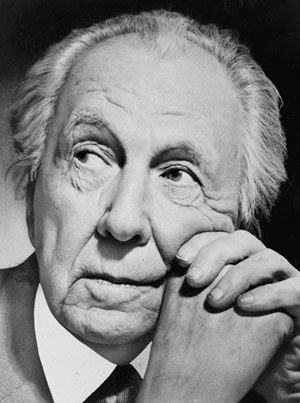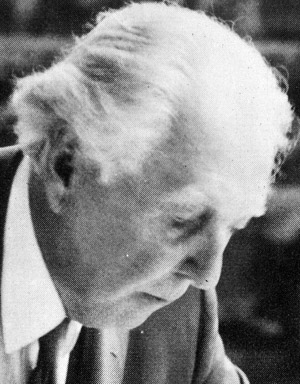Copyright Michael D. Robbins 2005
Astro-Rayological
Interpretation & Charts
Quotes
Biography
Images and Physiognomic Interpretation
A free America... means just this: individual freedom for all, rich or poor, or else this system of government we call democracy is only an expedient to enslave man to the machine and make him like it.
A great architect is not made by way of a brain nearly so much as he is made by way of a cultivated, enriched heart.
(Jupiter in 2nd house.)A man is a fool if he drinks before he reaches the age of 50, and a fool if he doesn't afterward.
All fine architectural values are human values, else not valuable.
All I learned from Eliel Saarinen was how to make out an expense account.
An architect's most useful tools are an eraser at the drafting board, and a wrecking bar at the site.
(Pluto in 5th house opposition Saturn.)An expert is a man who has stopped thinking - he knows!
An idea is salvation by imagination.
(Chiron in Pisces in 3rd house.)Art for art's sake is a philosophy of the well-fed.
Buildings, too, are children of Earth and Sun.
Bureaucrats: they are dead at 30 and buried at 60. They are like custard pies; you can't nail them to a wall.
Democracy is the opposite of totalitarianism, communism, fascism, or mobocracy.
Early in life I had to choose between honest arrogance and hypocritical humility. I chose the former and have seen no reason to change.
(Mars in Leo.)Every great architect is - necessarily - a great poet. He must be a great original interpreter of his time, his day, his age.
Form follows function - that has been misunderstood. Form and function should be one, joined in a spiritual union.
Freedom is from within.
(Sagittarius Ascendant.)Get the habit of analysis- analysis will in time enable synthesis to become your habit of mind.
Give me the luxuries of life and I will willingly do without the necessities.
(Venus in Taurus in 5th house trine Moon.)God is the great mysterious motivator of what we call nature, and it has often been said by philosophers, that nature is the will of God. And I prefer to say that nature is the only body of God that we shall ever see.
Harvard takes perfectly good plums as students, and turns them into prunes.
I believe in God, only I spell it Nature.
I believe totally in a Capitalist System, I only wish that someone would try it.
I feel coming on a strange disease - humility.
I find it hard to believe that the machine would go into the creative artist's hand even were that magic hand in true place. It has been too far exploited by industrialism and science at expense to art and true religion.
I have been black and blue in some spot, somewhere, almost all my life from too intimate contacts with my own furniture.
(Mars in 8th house.)I wouldn't mind seeing opera die. Ever since I was a boy, I regarded opera as a ponderous anarchronism, almost the equivalent of smoking.
I'm all in favor of keeping dangerous weapons out of the hands of fools. Let's start with typewriters.
(Sun & Mercury in Gemini.)If it keeps up, man will atrophy all his limbs but the push-button finger.
Less is only more where more is no good.
Life always rides in strength to victory, not through internationalism... but only through the direct responsibility of the individual.
(Saturn in Scorpio in 11th house.)Maybe we can show government how to operate better as a result of better architecture. Eventually, I think Chicago will be the most beautiful great city left in the world.
Mechanization best serves mediocrity.
Nature is my manifestation of God. I go to nature every day for inspiration in the day's work. I follow in building the principles which nature has used in its domain.
The heart is the chief feature of a functioning mind.
The screech and mechanical uproar of the big city turns the citified head, fill citified ears - as the song of birds, wind in the trees, animal cries, or as the voices and songs of his loved ones once filled his heart. He is sidewalk-happy.
The space within becomes the reality of the building.
The truth is more important than the facts.
(Sagittarius Ascendant.)There is nothing more uncommon than common sense.
"Think simple" as my old master used to say - meaning reduce the whole of its parts into the simplest terms, getting back to first principles.
Why, I just shake the buildings out of my sleeves.
To look at the cross-section of any plan of a big city is to look at something like the section of a fibrous tumor.
"Space. The continual becoming: invisible fountain from which all rhythms flow and to which they must pass. Beyond time or infinity."
"He exposes all the function on the top and puts the form below. It's as if you were to wear your entrails on top of your head." (referring to an unnamed, well-known architect of Wright's day)
"Move the chair." (Wright's response to a client who phoned him to complain of rain leaking through the roof of the house onto the dining table)
"Architecture is frozen music."
"I would like to have a free architecture. Architecture that belonged where you see it standing — and is a grace to the landscape instead of a disgrace."
"I can see the sham -- but where's the rock?" (commenting on the Shamrock Hotel in Houston, Texas)
"'Think simple' as my old master used to say. Meaning, reduce the whole of its parts into the simplest terms, getting back to first principles."
(Venus conjunct Pluto in 5th house.)"Simplicity and repose are the qualities that measure the true value of any work of art."
"Respect the masterpiece. It is true reverence to man. There is no quality so great, none so much needed now."
"I think Ms. Monroe's architecture is extremely good architecture." (on Marilyn Monroe)
"Toleration and liberty are the foundations of a great republic."
(Sagittarius Ascendant.)"A vital difference between the professional man and a man of business is that money making to the professional man should, by virtue of his assumption, be incidental; to the business man it is primary. Money has its limitations; while it may buy quantity, there is something beyond it and that is quality."
"I've been accused of saying I was the greatest architect in the world and if I had said so, I don't think it would be very arrogant, because I don't believe there are many [great architects] — if any. For 500 years what we call architecture has been phony."
(Virgo Moon square Sun.)"The one on my board right now." (what Wright said when asked which of his buildings was the most beautiful)
I hate intellectuals. They are from the top down. I am from the bottom up.
Youth is a quality, not a matter of circumstances.
"Many wealthy people are little more than janitors of their possessions."
"Business is like riding a bicycle. Either you keep moving or you fall down."
"I know the price of success: dedication, hard work, and an unremitting devotion to the things you want to see happen"
"The inappropriate cannot be beautiful"
"If capitalism is fair then unionism must be. If men have a right to capitalize their ideas and the resources of their country, then that implies the right of men to capitalize their labor."
"Nature is my manifestation of God. I go to nature every day for inspiration in the day's work. I follow in building the principles which nature has used in its domain"
You can't make an architect. But you can... open the doors and windows toward the light as you see it.
Frank Lloyd Wright was born as Frank Lincoln Wright in Richland Center in southwestern Wisconsin, on June 8, 1867 (a date sometimes reported as 1869). His father, William Carey Wright, was a musician and a preacher. His mother, Anna Lloyd-Jones was a teacher. It is said that Anna Lloyd-Jones placed pictures of great buildings in young Frank's nursery as part of training him up from the earliest possible moment as an architect. Wright spent some of his time growing up at the farm owned by his uncles near Spring Green, Wisconsin (also in the southwestern part of the state). Frank Lloyd Wright was of Welsh ethnic heritage, and was brought up in the Unitarian faith.
Wright briefly studied civil engineering at the University of Wisconsin in Madison, after which he moved to Chicago to work for a year in the architectural firm of J. Lyman Silsbee. In 1887, he hired on as a draftsman draftsman in the firm of Adler and Sullivan, run by Louis Sullivan (design) and Dankmar Adler (engineering) at the time the firm was designing Chicago's Auditorium Building. Wright eventuallly became the chief draftsman, and also the man in charge of the firm's residential designs. Under Sullivan, whom Wright called "Lieber Meister" (beloved master), Wright began to develop his own architectural ideas. In 1889 he married his first wife, Catherine Tobin. He also designed houses on his own toward the end, homes Wright called "bootlegged" which were done against Alder and Sullivan's policies concerning such moonlighting. When Louis Sullivan found out about these homes, Wright was fired from the firm.The bootlegged houses showed the start of Wright's low, sheltering rooflines, the prominence of the central fireplace, nd "the destruction of the box" open floorplans. The Adler and Sullivan firm was just the right place to be for a young man aspiring to be a great architect, as it was at the leading edge of American architecture at the time.
Wright started his own firm in 1893 after being fired from Adler and Sullivan, first working out of the Schiller building (designed by Adler and Sullivan) and then out of a studio which was built onto his home in Oak Park, an affluent suburb of Chicago which is located just to the west of the center of the city.
Between 1893 and 1901, 49 buildings designed by Wright were built. During this period he began to develop his ideas which would come to t ogether in his "Prairie House" concept. Into 1909, he developed and refined the prairie style. Frank Lloyd Wright founded the "prairie school" of architecture, and his art of this early productive period in his life is also considered as part of the "Arts and Crafts movement".
This very productive first phase in Wright's career ended in 1909, when he left his wife and 5 children to go to Germany. He was joined there by Mamah Borthwick Cheney, the wife of a former client and now his lover. From 1912-1914, Wright and Ms. Chaney lived together at Taliesin, a home Wright had built at the site of his uncles' farm near Spring Green. This period ended when a crazed servant murdered Ms. Chaney and 6 others, also setting a fire that destroyed much of Taliesin.
During the period from 1914-1932, a time of personal turmoil and change, Wright rebuilt Taliesin (and nearly lost it to bank forclosure), divorced Catherine, married and separated from Miriam Noel (spending a little time in jail as part of this situation), and met his third wife, Olgivanna Milanoff (a Bosnian Serb who was a student of G. I. Gurdjieff). Architectural designs during this period included the Imperial Hotel in Tokyo (a large and complex design that required much time in Japan to oversee it), and the concrete California residences. Few commissions were completed toward the end of this period, but Wright did lecture and publish frequently, with books including An Autobiography in 1932.
The Taliesin Fellowship was founded in 1932, with thirty apprentices who came to live and learn under Mr. Wright. An Autobiography served as an advertisement, inspiring many who read it to seek him out. The architect's output became more organized and prolific, with help of the numerous apprentices who assisted in design detail and site supervision. His most famous work, Fallingwater, was designed in 1936. The fellowship was expanded as Taliesin West was built in Arizona as a winter location for the school. The Taliesin Associated Architects, the Frank Lloyd Wright School of Architecture, and the Frank Lloyd Wright Foundation are living legacies of what Mr. Wright founded in 1932.
Few buildings wre produced during the war years, but the G.I.Bill brought many new apprentices when the war ended. This post-war period to the end of Wright's life was the most productive. He received 270 house commissions, and designed and built the Price Tower skyscraper, the Guggenheim Museum (which required Wright to live in New York City for a time), and the Marin County Civic Center.
Wright never retired; he died on April 9, 1959 at the age of ninety-two in Arizona. He was interred at the graveyard at Unity Chapel (which is considered to be his first building) at Taliesin in Wisconsin. In 1985, Olgivanna Wright passed away, and one of her wishes was to have Frank Lloyd Wright's remains cremated and the ashes placed next to hers at Taliesin West. Amid much controversy, this was done. The epitaph at his Wisconsin grave site reads: "Love of an idea, is the love of God"
Frank Lloyd Wright was born in Richland Center, Wisconsin on June 8, 1867. His parents, William Cary Wright and Anna Lloyd-Jones, originally named him Frank Lincoln Wright, which he later changed after they divorced. When he was twelve years old, Wright's family settled in Madison, Wisconsin where he attended Madison High School. During summers spent on his Uncle James Lloyd Jones' farm in Spring Green, Wisconsin, Wright first began to realize his dream of becoming an architect. In 1885, he left Madison without finishing high school to work for Allan Conover, the Dean of the University of Wisconsin's Engineering department. While at the University, Wright spent two semesters studying civil engineering before moving to Chicago in 1887.
In Chicago, he worked for architect Joseph Lyman Silsbee. Wright drafted the construction of his first building, the Lloyd-Jones family chapel, also known as Unity Chapel. One year later, he went to work for the firm of Adler and Sullivan, directly under Louis Sullivan. Wright adapted Sullivan's maxim "Form Follows Function" to his own revised theory of "Form and Function Are One." It was Sullivan's belief that American Architecture should be based on American function, not European traditions, a theory which Wright later developed further. Throughout his life, Wright acknowledged very few influences but credits Sullivan as a primary influence on his career. While working for Sullivan, Wright met and fell in love with Catherine Tobin. The two moved to Oak Park, Illinois and built a home where they eventually raised their five children. In 1893, Sullivan and Wright ended their business relationship. Wright opened his own firm in Chicago, which he operated there for five years before transferring the practice to his home in Oak Park.
Wright's early houses revealed a unique talent in the young, aspiring architect. They had a style all their own, mimicking that of a horizontal plane, with no basements or attics. Built with natural materials and never painted, Wright utilized low-pitched rooflines with deep overhangs and uninterrupted walls of windows to merge the horizontal homes into their environments. He added large stone or brick fireplaces in the homes' heart, and made the rooms open to one another. His simplistic houses served as an inspiration to the Prairie School, a name given to a group of architects whose style was indigenous of midwestern architecture. Later he became one of its chief practitioners. Some of his most notable creations include the Robie House in Chicago, Illinois and the Martin House in Buffalo, New York.
In 1909, after eighteen years in Oak Park, Wright left his home to move to Germany with a woman named Mamah Borthwick Cheney. When they returned in 1911, they moved to Spring Green, Wisconsin where his mother had given him a portion of his ancestors' land; it was the same farm where he had spent much time as a young boy. In Spring Green he constructed Taliesin. They lived there until 1914 when tragedy struck. An insane servant tragically murdered Cheney and six others, then set fire to Taliesin. Many people thought this horrific event would be the end of Wright's career. He proved them wrong however, with his decision to rebuild Taliesin.
Over the next 20 years Wright's influence continued to grow in popularity in the United States and Europe. Eventually his innovative building style spread overseas. In 1915, Wright was commissioned to design the Imperial Hotel in Tokyo. It was during this time that Wright began to develop and refine his architectural and sociological philosophies. Because Wright disliked the urban environment, his buildings also developed a style quite different from other architects of the time. He utilized natural materials, skylights and walls of windows to embrace the natural environment. He built skyscrapers that mimicked trees, with a central trunk and many branches projecting outward. He proclaimed that shapes found in the environment should be not only integrated, but should become the basis of American architecture. A great example is the Larkin Company Administration Building in Buffalo, New York (1903), and the Guggenheim Museum in New York City (1943), which resembles the structure of a shell or a snail.
In 1932, Wright opened Taliesin up as an architectural fellowship where young students could pay to work with and learn from him. Thirty apprentices came to live with him at Taliesin. Through the Taliesin Fellowship, Wright created masterpieces such as Fallingwater (the Kaufmann House) in Mill Run, Pennsylvania, and the SC Johnson and Son Wax Company Administration Center in Racine, Wisconsin. During this time, he married and separated from Miriam Noel and met his third wife, Olivanna Milanoff. The two lived happily at Taliesin for five years and raised a child there. As the couple grew older, the Wisconsin winters became too much for them. In 1937, Wright moved his family and fellowship to Phoenix, Arizona where he built Taliesin West and spent the last twenty years of his life.
At Taliesin West, because of the comfortable year-round climate, Wright was able to integrate the outdoors with his indoor spaces. He designed high sloping roofs, translucent ceilings, and large, open doors and windows that created a subtle distinction between the home and the environment. Both Taliesin and Taliesin West were continuous living experiences for Wright as they constantly remained under construction. As his fellowship grew and the need for a larger facility became necessary, Wright continued to create additions and expansions on both homes.
On April 9, 1959 at age ninety-two, Wright died at his home in Phoenix, Arizona. By the time of his death, he had become internationally recognized for his innovative building style and contemporary designs. He had created 1,141 designs, of which 532 were completed. His name had become synonymous with great design, not only because of the form of his designs, but also because of the function. In the end, he showed not just what to live in, but more importantly he influenced the very nature of how we lived.
Frank Lloyd WrightFrank Lloyd Wright (June 8, 1867 – April 9, 1959) was one of the most prominent architects of the first half of the 20th century. To this day he easily America's most famous architect (topping Philip Johnson, Louis Kahn, and Frank Gehry) and still extremely well-known in the common public's eye.
He was born in the agricultural town of Richland Center, Wisconsin, USA and brought up with strong Unitarian and transcendental principles, eventually designing the Unity Temple in Oak Park, Illinois. As a child he spent a great deal of time playing with the Kindergarten educational blocks by Friedrich Wilhelm August Fröbel (popularly known as Froebel's blocks) given by his mother. These consisted of various geometrically shaped blocks that could be assembled in various combinations to form three dimensional compositions. Wright in his autobiography talks about the influence of these exercises on his approach to design. Many of his buildings are notable for the geometrical clarity they exhibit.
Wright commenced his formal education in 1885 at the University of Wisconsin School for Engineering, where he was a member of a fraternity, Phi Delta Theta. He took classes part time for two years while apprenticing under Allen Conover, a local builder and professor of civil engineering. In 1887, Wright left the university without taking a degree (although he was granted an honorary doctorate of fine arts from the university in 1955) and moved to Chicago, Illinois, where he joined the architectural firm of Joseph Lyman Silsbee. Within the year, he had left Silsbee to work for the firm of Adler and Sullivan. Beginning in 1890, he was assigned all residential design work for the firm. In 1893, after a falling out that probably concerned the work he had taken on outside the office, Wright left Adler and Sullivan to establish his own practice and home in the Chicago suburb of Oak Park, IL. He had completed around fifty projects by 1901 including many houses in his hometown.[1]
Between 1900 and 1910, his residential designs were "Prairie Houses" (extended low buildings with shallow sloping roofs, clean sky lines, suppressed chimneys, overhangs and terraces, using unfinished materials), so called because the design is considered to complement the land around Chicago. These houses are credited with being the first examples of the "open plan>" In fact, the manipulation of interior space in residential and public buildings [such as Unity Temple] are hallmarks of his style. He believed that humanity should be central to all design. Many examples of this work can be found in Buffalo, New York, resulting from a friendship between Wright and an executive from the Larkin Soap Company, Darwin D. Martin. In 1902 the Larkin Company decided to build a new administration building. Wright came to Buffalo and designed not only the first sketches for the Larkin Darwin Martin House, Buffalo, New YorkThe houses considered the masterpieces of the late Prairie period (1907-1909) are the Frederick Robie House and the Avery and Queene Coonley House, both in Chicago. The Robie House with its soaring cantilevered roof lines, supported by a 110 foot long channel of steel, is the most dramatic. Its living and dining areas form virtually one uninterrupted space. This building had the most influence on young European architects after World War I and is called the "cornerstone of modernism." In 1910, the Wasmuth Portfolio was published, and created the first major exposure of Wright's work in Europe.
He designed his own home-studio complex, called Taliesin (after the 6th century Welsh poet, whose name means literally 'shining brow'), which was begun near Spring Green, Wisconsin in 1911 and modified and expanded many times over. The complex was a distinctive low one-story U-shaped structure with views over a pond on one side and Wright's studio on the opposite side. Taliesin was twice destroyed by fire; the current building there is called Taliesin III. The first time it burned, seven people were killed, including Wright's mistress, Mamah Borthwick, and her two children (by her husband Edwin Cheney).
He visited Japan, first in 1905, and Europe (1909-10), opening a Tokyo office in 1916. In the 1938 Wright designed his winter retreat in Arizona, called Taliesin West; the retreat, like much of Wright's architecture, blends organically with the surrounding landscape. In Tokyo, Wright designed his famous Imperial Hotel, completed in 1922 after beginning construction in 1916. On September 1, 1923, one of the worst earthquakes in modern times hit Tokyo and its surrounding area. The Great Kanto Earthquake completely leveled Tokyo and effects from the earthquake caused a large tsunami, destructive tornados, and fires in the city. A legend grew out of this disaster that Wright's Imperial Hotel was the only large structure to survive the destruction, but in fact this was far from true.
Wright is responsible for a concept or a series of extremely original concepts of suburban development united under the term Broadacre City. He proposed the idea in his book The Disappearing City in 1932, and unveiled a very large ( 12 by 12 feet) model of this community of the future, showing it in several venues in the following years. He went on developing the idea until his death.
Wright built 362 houses. About 300 survive as of 2005. Only one was lost to forces of nature, a waterfront home in Mississippi destroyed by a hurricane in the 1960s; although, the Ennis-Brown House in California had been damaged by earthquake and rain-induced ground movement. While a number of the houses are preserved as museum pieces and millions of dollars are spent on their upkeep, other houses have trouble selling on the open market due to their unique designs, generally small size and outdated features. As buildings age their structural deficiencies are increasingly revealed, and Wright's designs have not been immune from the passage of time. Some of his most daring and innovative designs have required major structural repair, and the soaring cantilevered terraces of Fallingwater are but one example. (A common joke was once how "Fallingwater" is falling into the water.) Some of these deficiencies can be attributed to Wright's pushing of materials beyond the state of the art, others to sometimes less than rigorous engineering, and still others to the natural wear and tear of the elements over time.

